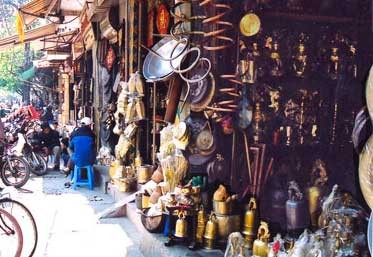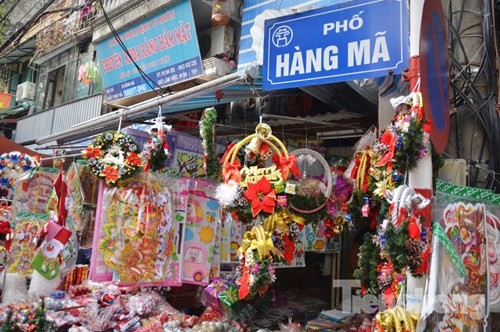To Tuan -
(VOVworld)- Hanoi's Old Quarter has a long history and represents the eternal soul of the city. Although the Old Quarter is often called the "36 Old Streets," there are actually more than 36 streets. In the 15th century, skilled craftsmen began migrating to the Old Quarter, and guilds were formed by craftsmen from the same village.

Hang Dong street |
In 1010, King Ly Thai To relocated the capital from Hoa Lu to Thang Long, the original name of Hanoi. In the edict to relocate the capital, King Ly Thai To highlighted the sacredness and strategic importance of Hanoi. During the Ly dynasty, there were 61 administrative agencies governing activities in residential areas. Historian Nguyen Quang Ngoc: “This is the transit point of traffic routes and trade exchanges and an important residential and economic place”.
The capital city of Thang Long was a meeting place of skilled artisans who came from different craft villages and gathered in Thang Long to set up craft guilds. There they continued to follow their home village’s customs and traditions. During the French colonial regime, the Old Quarter was upgraded with new drainage systems, sidewalks, lighting, and brick houses. Many houses were built in a European architectural style. Since Hanoi’s liberation in 1954 and especially since the renewal process began in 1986, the Old Quarter of Hanoi has been upgraded and changed dramatically. Trading in the area has become busier. Of the 76 streets in the Old Quarter, 47 retain their original name which reflect the type of goods that were produced and sold on that street. Tran Viet Anh is Deputy Head of the Hanoi Old Quarter Management Committee: “A number of old architectural and historical relics remain in the Old Quarter. So do the customs of the traditional craft villages and former Hanoi lifestyles. These are important cultural values”.

Hang Ma street |
Walking along streets in the Old Quarter, it’s easy to tell the name of a street from the goods sold in shops and even the sound heard on the street.
The Old Quarter has a rich religious heritage. When the craftsmen moved from outlying villages into the capital, they brought with them their religious practices. Each guild has one or two religious structures honoring the craft founders, and on each street in the Old Quarter there is at least one temple or shrine. People in the Old Quarter still follow the traditional religious practices and lifestyle. Mr. Vinh lives in Hang Giay street: “Hanoi people love peace. They have a close relationship with their neighbors and often help each other. They respect trust in doing business and etiquette in daily life”.
Though the names of some guild streets no longer reflect the local trade, many traditions and customs of Hanoi’s Old Quarter linger on.
To Tuan